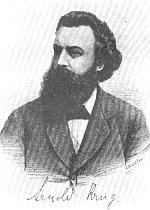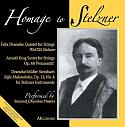ARNOLD KRUG: Sextet in D Major for Two Violins, Viola, Violotta, Cello, and Cellone, Op. 68
|
Program notes prepared by Alan Krueck for the premiere recording of Krug's Preis Sextet for AK/Coburg Recordings. |
|
ARNOLD KRUG: Sextet in D Major for Two Violins, Viola, Violotta, Cello, and Cellone, Op. 68
In his foreword to Wollenweber Verlag first edition of Draeseke’s Stelzner Quintet Udo Follert writes that in May 1896 the Dresden Conservatory announced a prize competition which was intended to bring attention to and stimulate interest for the newly designed and developed members of the string family by Alfred Stelzner, above all the violotta. While it seems reasonable that Felix Draeseke, as a member of the conservatory faculty, had some role in final decisions about prize winners, his work was neither written for nor submitted to the competition. As it turns out the prize was shared by Arnold Krug (1849 -1904) and Eduard Behm (1862-1946), each of whom won for the sextet combination of normal string quartet, violotta and cellone. Follert reports that a large number of string quartets submitted evidently aroused little attention. Both prize winning works were published and both offered alternative 2nd viola and 2nd cello sanctions for performances where violotta and cellone were not available. The only other known work published with Stelzner instruments in mind, is a Sextet in F major excluding the cellone in favor of a contrabass though otherwise for the same combination as that by Behm and Krug, written for the competition and submitted by the Austrian composer Theodor Streicher (1874-1940). Interestingly enough Streicher’s Breitkopf & Härtel publication carries with it the printed condition: "In public performance the violotta may not be replaced by any other instrument!"
The first movement (D major, 4/4) begins dramatically with an aggressive gesture, a feint before the decrescendo which leads to the exposition proper and the malleable main theme, but the opening encompasses at least three figures which appear later throughout the movement as important, one might say accompanimental anti-lyrical developmental motives which help to steer the major themes through interesting harmonic changes and appealing contrapuntal combinations. For the most part, however, the movement is a fairly straight forward sonata-allegro design, with obligatory repeat of the exposition. Some may note a curious parallel in the rhythmically charged dotted quarter note / double 32nd note developmental motive heard after the initial two ff at the beginning and a similar one in the first movement of Anton Bruckner’s string quintet, especially since both are utilized in the same fashion. The ensuing Adagio tranquillo (F major, 4/4) begins in untroubled grand repose, with a lyrical theme asserting itself over contrapuntal weavings and rising to a climax with full ensemble. Subsiding, the music suddenly is taken forward by a rhythmically animated 16th note motive and the harmonic tension increases until a climax is reached. A flat major is established and a second theme is taken up for development. The 16th note motion returns and the music is led to a climax, slowly losing momentum until it comes to rest with fermata on an unresolved chord. A transitional passage of elegiac nature leads back to a repeat of the opening and the movement ends quietly in the home key. The Finale (D major, 4/4) is a bright and bustling rondo, whose episodes are clearly defined by either key change, or change of emphasis of note values for new ideas. Sections of elongations are contrasted with sections of clipped, virtuosic brilliance, straight 4/4 pulse with a section dominated by triplet motion , the triplet dominated section being usurped by one dominated by 16th note activity. At letter N the movement reaches its climactic lyrical pinnacle, followed by a brief denouement which bursts into the brilliant and sonorous coda. |
|
|
|
ARNOLD KRUG Sextett In D-Dur Für Zwei Violinen, Viola,
Violotta, Violoncello Und Cellone, Op. 68
In dem Vorwort zur Erstausgabe des Stelzner Quintetts von Felix Draeseke schreibt Udo-R. Follert, daß im Mai 1896 ein Preisausschreiben des Dresdner Konservatoriums bekanntgegeben wurde, welches Stelzners neue Instrumente fördern und bekannt machen sollte, vor allem die Violotta. Obwohl Draeseke sicher als Fakultätsmitglied des Konservatoriums eine Rolle bei der Preisverleihung spielte, wurde sein Stelznerquintett weder für diesen Wettbewerb geschrieben noch eingereicht. Den ersten Preis teilten zwei beachtenswerte Sextette von Arnold Krug (1849-1904) und Eduard Behm (1862-1946 ). Follert berichtet, daß mehrere Quartette eingereicht wurden, aber daß sie wenig Beachtung erhielten. Die Sextette von Krug und Behm sind für normale Streichquartettbesetzung, Violotta und Cellone geschrieben. Bei der Veröffentlichung der Werke wurde als Ersatz für Violotta eine zweite Viola und für die Cellone ein zweites Violoncello empfohlen. Das einzige andere veröffentlichte Stück für Stelzner Instrumente ist ein Sextett in F-dur, das für das Preisausschreiben von dem Österreicher Theodor Streicher (1874-1940) komponiert wurde, worin ein Kontrabaß die Stelle des Cellone in einer Krug und Behm ähnlichen Besetzung übernimmt.Ganz interessant ist es, daß Streichers Veröffentlichung bei Breitkopf und Härtel ausdrücklich betont: „Die Violotta darf bei öffentlichen Aufführungen nicht durch ein anderes Instrument ersetzt werden.“
Der erste Satz (D-dur, 4/4) fängt dramatisch mit aggressiven Gesten an, einem Scheinangriff, ehe ein Decrescendo die Musik zu wirklichem Beginn des Satzes und der Darstellung des Hauptthemas führt. Diese anfänglichen Gesten enthalten mindestens drei scheinbar nebensächliche Motive, die später im Satz auftauchen, und sich als wichtige, sozusagen begleitende anti-lyrische Entwicklungsmotive erweisen, da sie dazu beitragen, die Hauptthemen durch interessante harmonische Änderungen und angenehme kontrapunktische Kombinationen zu führen. Im grossen und ganzen ist der Satz aber musterhaft in der normalen Auslegung eines Sonatensatzes, mit der obligatorischen Wiederholung des ersten Teils. Der aufmerksame Hörer dürfte eine auffallende Parallele zwischen dem rhythmisch aus punktiertem 8tel und zwei 32tel Noten bestehenden Entwicklungsmotiv, das sich gleich nach dem beginnenden ff-Akkorden hören läßt, und einem sehr ähnlichen Motiv im ersten Satz des Streichquintetts von Anton Bruckner hören. Der darauffolgende zweite Satz Adagio tranquillo (F-dur, As-dur, 4/4) fängt in ungestörter, ruhiger Sorglosigkeit mit einem lyrischen Hauptgedanken an, der sich durch kontrapunktisches Gewebe bewegt und die Musik zu einem ersten Höhepunkt führt. Danach abklingend, übernimmt die Musik ein rhythmisch animiertes 16tel Motiv, und die harmonische Spannung steigert sich, bis ein weiterer Höhepunkt erreicht wird. Im erreichten As-dur wird ein zweites Thema entwickelt. Die 16tel Bewegung kehrt zurück und die Musik erstrebt noch einen Höhepunkt, wonach die langsam verebbende Musik bei einer Fermate auf einem Dissonanzakkord hält. Eine elegische Übergangspassage führt zur Wiederholung des Anfangs, und der Satz schließt in der Haupttonart ruhig ab. Das Finale (D-dur, 4/4) ist ein heller und gesanglicher Sonatensatz, dessen Teile entweder durch Tonartänderung oder Betonungsänderungen der Notenwerte neu definiert werden. Das Hauptthema besteht hauptsächlich aus rhythmisierten 16tel-Noten. Abschnitte gedehnter Werte werden Abschnitten mit scharf geschnittenem Tempoprofil und virtuosem Glanz gegenübergestellt. Das zweite Thema wird aus wunderschönen lyrischen choralartigen Melodien gebildet, die nicht nur in ihrer Länge sondern im Tonartwechsel von D-dur zu B-dur beim Buchstaben C mit dem ersten Thema scharf kontrastieren. Durchführung und Reprise sind eher normal, aber beim Buchstaben N erreicht der Satz seinen lyrischen Gipfel. Der Pulsschlag von geraden Viertelnoten scheint zu verebben, als ein Triolenteil den Lauf der Musik übernimmt. Das erste Thema lässt den Satz brillant und triumphal ausklingen. © Alan H. Krueck |
| Krug's String Sextet on CD: | |
The Summit Chamber Players (Naomi Gjevre and Javier Pinell, violins; James Przygocki, viola; John Thomson, violotta; Barbara Thiem, cello; Richard Rognstad, cellone) |
|
[Chamber Music] [Orchestral Music] [Keyboard Music] [Listen: mp3] [Top]
© All contents copyright by the International Draeseke Society
 Arnold Krug
Arnold Krug